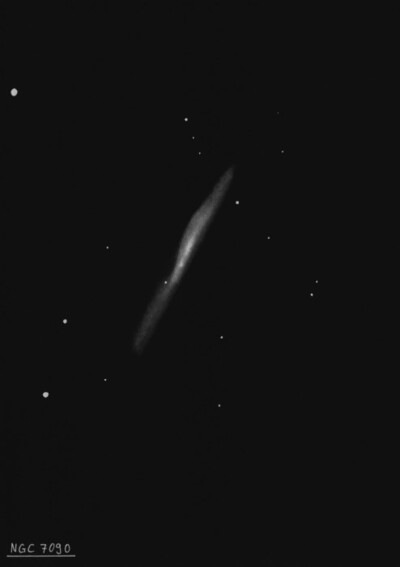
John Herschel discovered NGC 7090 = h3872 on 4 Oct 1834 and recorded "pB; L; vmE in pos 127.1°; first gradually, the pretty suddenly lbM to a v feeble nucleus; 4' l, 40" br; has a * 11m preceding. In the foreground of the Pavo-Indus Cloud which includes NGCs 7213, 7205, 7049, 7083 and 7144.
200/250mm - 11" (8/8/04 - Haleakala Crater): moderately bright, fairly large, edge-on 5:1 NW-SE, 4.0'x0.8', broad concentration but with no distinct core. Irregular surface brightness with a mottled appearance at 127x. Appears to fade suddenly in a couple of spots (possibly due to dust) including just SE of a mag 14 star that is superimposed on the SE side. Viewed at an elevation of 13°.
600/800mm - 25" (10/21/17 - OzSky): at 244x; bright, very large irregular edge-on ~7:1 NW-SE, ~5'x0.7'. Overall the galaxy has a striking patchy appearance with an irregular surface brightness (somewhat similar to NGC 253). It contains a very elongated, sightly brighter core region with a mag 14 star superimposed just southeast of the core. The entire northern flank of the galaxy is very uneven or patchy due to dust patches or a dust lane. The surface brightness of the galaxy drops significantly as it extends southeast of the star for ~2'. The northwest wing beyond the core dims more gradually to the tip. A mag 9 star (HD 205124) is located 12' W, a mag 9.3 star (HD 205308) is 8' N, and a 1.2' pair of mag 9.5/10 star is ~7' NE.
Notes by Steve Gottlieb